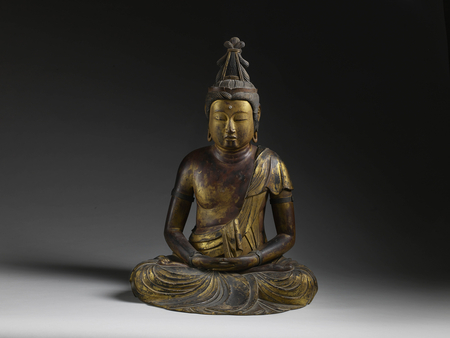Product Description
5883 A lacquer and gilt wood figure of Dainichi Nyorai (Mahāvairocana) wearing flowing robes and seated in kekka-fusa (lotus position), his hands in Hokkai jō-in mudra (concentration of the Dharma-realm), the hair is arranged in a tall standing top knot, gyokugan (inlaid crystal eyes), the forehead adorned with a crystal representing the byakugō (white spiralling hair), arms and wrists accessorised with gilt metal armlets and bracelets
Japan 17th century Edo period
Inscribed and dated:
Kyo-busshi Kani Yoyaku Tomon, Kanbun juni, koyomi ne no shôgatsu kichijitu kore (o) tsukuru (Made by Kani Tomon the Buddha sculptor of Kyoto. On the first month of Kanbun 12th year of the rat (1672)
Dimensions: H. 60cm x W.42cm x D.37cm (23¾” x 16¾” x 14¾”)
Dainichi (Great Sun) is the central and supreme deity of the pantheon of Esoteric Buddhism. In origin he has been linked to an ancient sun cult and to the Zoroastrian god of light, Ashura Mazda. In Brahmanical literature the appellation Vairocana (primordial or supreme Buddha) appears, for example, as the name of a legendary king and of the king of the Ashura. In Buddhism he assumes a central role in Esoteric Buddhism he eventually took the place of Shaka (the Historical Buddha), as expositor of the Buddhist teachings, becoming the central figure in the Esoteric Buddhist pantheon as represented by the Taizokai Mandara (Womb World Mandala) and Kongokai Mandara (Diamond World Mandala). In Japan Dainichi also figures among the so-called Jusanbutsu (Thirteen Buddhas), presiding over the memorial service held on the 12th anniversary of a person’s death.
Dainichi differs iconographically from other Buddhas in that he is represented in the form of a Bosatsu, seated, wearing silk robes and accessories such as armlets and bracelets, and having long locks of hair. He also wears a Gochi Houkan (five-wisdom bejewelled crown) on his head, symbolising his identity with the Gobutsu (Five Buddha) and Gochi Nyorai (the five wisdoms) attributed to them.
Dainichi may be identified by his distinctive hand-gestures: in the Taizokai Mandara he forms the hokkai jouin (Concentration seal of the Dharma-realm), with both hands lying on his lap, right on top of left, palms upward and thumbs touching, while in the Kongokai Mandara he forms the chiken-in (seal of the knowledge fist), with the clenched right hand posed over the extended index finger of the otherwise clenched left hand.
For a similar example from the 13th century, Kamakura period, in the Saimyoji temple, Shiga prefecture, see Miho Museum et al eds., Omi: Spiritual Home of Kami and Hotoke, exhibition catalogue, (Kyoto, 2011), p.205, no. 28.
Radio Carbon Dating Ref: RCD- 7455








